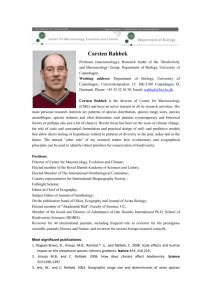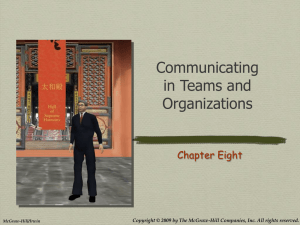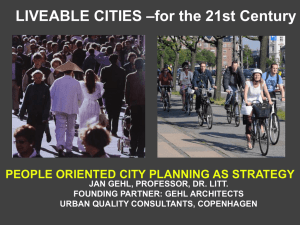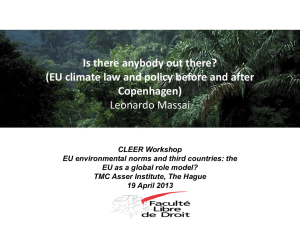pptx
advertisement
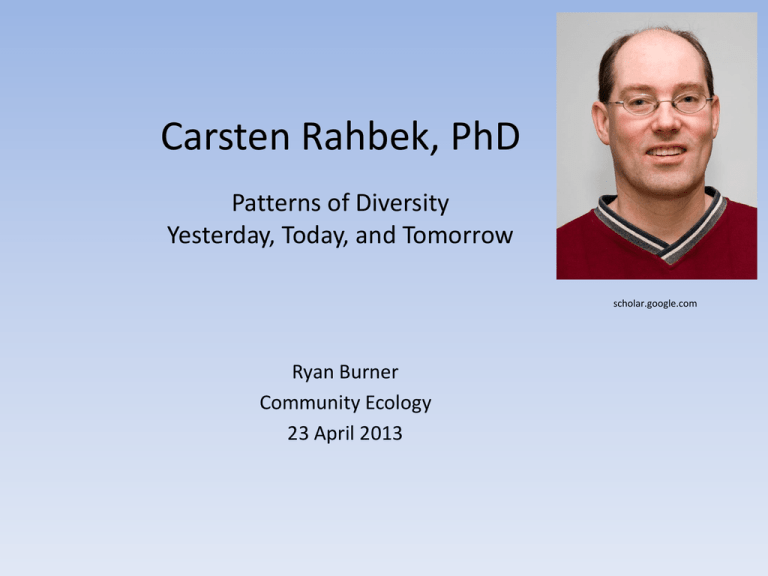
Carsten Rahbek, PhD Patterns of Diversity Yesterday, Today, and Tomorrow scholar.google.com Ryan Burner Community Ecology 23 April 2013 Education University of Copenhagen, Denmark, Biology, B.Sc., 1988 University of Wisconsin, USA, visiting graduate student, 1990 - 1991 University of Copenhagen, Denmark, Zoology, M.Sc., 1992 Smithsonian Institution, NMNH, Research Fellow 1993 - 1995 University of Copenhagen, Denmark, Biogeography, PhD, 1995 Appointments Currently: Professor and Director, Center for Macroecology, Evolution and Climate at University of Copenhagen and President-Elect, International Biogeography Society 2005-present. Full Professor, Department of Biology, Univ. of Copenhagen, Denmark; 2001-2005. Professor MSO, Zoological Museum, Univ. of Copenhagen, Denmark; 1995-2005. Head of the Copenhagen Bird Ringing Centre & Curator of Birds; 1998-2001. Associate Professor, Zoological Museum, Univ. of Copenhagen, Denmark; 1995-1998. Assistant Professor, Zoological Museum, Univ. of Copenhagen, Denmark. http://blog.ujjvalpanchal.com/ Research Interests “Center for Macroecology, Evolution and Climate” Shahid Naeem; http://macroecology.ku.dk/ • Patterns of species distribution, species range sizes, species assemblages, species richness and • Mechanisms that determine these patterns – “contemporary and historical factors or perhaps also just a bit of chance” Early Work • A survey of the montane forest avifauna of the Loja province, southern Ecuador; 1991. H. Bloch, M. K. Poulsen, C. Rahbek, J. F. Rasmussen • Lista de aves del Parque Nacional Podocarpus 1992. J. F. Rasmussen, M. K. Poulsen, C. Rahbek, H. Bloch • Avian body weights from southern Equador 1993. C. Rahbek, H. Bloch, M. K. Poulsen, J. F. Rasmussen Orange-headed Tanager wikipedia.com Species Richness, Gradients, Patterns, and Mechanisms • The elevational gradient of species richness: a uniform pattern? 1995. C. Rahbek – 493 citations, beginning of a major theme in his work • The relationship among area, elevation, and regional species richness in neotropical birds 1997. C. Rahbek biogeography.org Species Richness, Gradients, Patterns, and Mechanisms • The functional biogeography of species: biogeographical species roles of birds in Wallacea and the West Indies 2013. D. W. Carstensen, B. Dalsgaard, J. C. Svenning, C. Rahbek, J. Fjeldså, W. J. Sutherland, J. M. Olesen • The role of mountain ranges in the diversification of birds 2012. J. Fjeldså, R. C. K. Bowie, C. Rahbek • Dispersion fields, diversity fields and null models: uniting range sizes and species richness 2010. M. K. Borregaard, C. Rahbek • Predicting continental-scale patterns of bird species richness with spatially explicit models 2007. C. Rahbek, N. J. Gotelli, R. K. Colwell, G. L. Entsminger, T. Rangel, G. R. Graves s • J. Fjeldså N. Sanders w/ CR G. Graves R. Colwell N. Gotelli Conservation and Biogeography • Species richness and endemism in South American birds: implications for the design of networks of nature reserves 1997. J. Fjeldså, C. Rahbek • Continent-wide conservation priorities and diversification processes 1998. J. Fjeldså, C. Rahbek • Priorities for conservation in Bolivia, illustrated by a continent-wide analysis of bird distributions 1998. J. Fjeldså, C. Rahbek • Conserving biodiversity in a world of conflicts 2007. M. B. Araújo, C Rahbek x Holt et al. 2012 Redrawing Wallace’s Eco-regions by Taxa, using Phylogenetic Relationships Holt et al. (2012) Recent Focus • On “the effect of climate change, the role of scale and conceptual formulation, and practical design of null- and predictive models that allow direct testing of hypotheses related to patterns of diversity” • Views his theoretical work as informing conservation priority setting and hypothesis testing Effects of Climate Change on Species Diversity • Habitat stability affects dispersal and the ability to track climate change 2012. C. Hof, M. Brändle, D. M. Dehling, M. Munguía, R. Brandl, M. B. Araújo, C. Rahbek • Using species co‐occurrence networks to assess the impacts of climate change 2011. M. B. Araújo, A. Rozenfeld, C. Rahbek, P. A. Marquet • Additive threats from pathogens, climate and land-use change for global amphibian diversity 2011. C. Hof, M. B. Araújo, W. Jetz, C. Rahbek Habitat Stability, Dispersal, and the ability to track Climate Change Hof et al. 2012 Elevational Gradients in Species Diversity • A major recurring theme in Carsten Rahbek’s research, and my focus for the rest of this presentation Gradients in Species Diversity • The patterns and causes of elevational diversity gradients 2012. N. J. Sanders, C. Rahbek • Contrasting patterns of phylogenetic assemblage structure along the elevational gradient for major hummingbird clades 2011. J. L. Parra, C. Rahbek, J. A. McGuire, C. H. Graham • Elevational zonation of afrotropical forest bird communities along a homogeneous forest gradient 2009. T. S. Romdal, C. Rahbek • Scale effects and human impact on the elevational species richness gradients 2008. D. Nogués-Bravo, M. B. Araújo, T. Romdal, C. Rahbek • The Mid‐Domain Effect: There’s a Baby in the Bathwater 2005. R. K. Colwell, C Rahbek, NJ Gotelli • The Mid‐Domain Effect and Species Richness Patterns: What Have We Learned So Far? 2004 R. K. Colwell, C. Rahbek, N. J. Gotelli Latitudinal Gradients in Species Diversity • One of the ‘most universal biogeographic patterns’ Marine Fish Species by Latitude Pacific Atlantic From Rohde (1978) and Rohde (1993), combined in Rohde (2011) Latitudinal and Elevational Gradients Similarities -Generally declining diversity -Generally declining temperatures -Generally declining vegetation cover and primary productivity Differences -Seasonality -Location of humidity peak -Scale -Replication What Pattern? A First Question From Rahbek (1995) From Rahbek (1995) The Richness/Elevation Relationship Locally Raw Data From Rahbek (1995), citing Terborgh (1977) Standardized The Richness/Elevation Relationship Continent Wide Raw Data From Rahbek (1995) Standardized Simple Models of Observed Distributions Rahbek (1997) Models predicting a monotonic decline Monotonic Richness/ Productivity Rahbek (1997) Rapoport’s ‘Rule’ Models predicting a hump-shaped distribution Hump-shaped Species/ Productivity relationship Rahbek (1997) Models predicting a hump-shaped distribution Bounded Random Geographical Ranges Rahbek (1997) Simple Models of Observed Distributions Rahbek (1997) Range of Elevational Gradient (m) Sampling Effects: multiple draws from the same data set Rahbek (2008) Spatial Grain Size (km^2) Range of Elevational Gradient (m) Sampling Effects: multiple draws fro the same data set Rahbek (2008) Spatial Grain Size (km^2) Range of Elevational Gradient (m) Sampling Effects: multiple draws from the same data set 1 Rahbek (2008) 25 Spatial Grain Size (km^2) 81 Worldwide Average Human Impact by Elevation Percent Original Vegetation Rahbek (2008) Human Impact Index Proposed Mechanisms • Some of the most frequently tested: – climate and productivity – source-sink dynamics – mass and area effects – disturbance – geometric factors – evolutionary history – competition N. J. Sanders and C. Rahbek (2012) Thanks science.ku.dk For Future Reference Colwell, R. K., et al. (2004). "The Mid‐Domain Effect and Species Richness Patterns: What Have We Learned So Far?" The American Naturalist 163(3): E1-E23. Colwell, R. K., et al. (2005). "The Mid‐Domain Effect: There’s a Baby in the Bathwater." The American Naturalist 166(5): E149-E154. Hof, C., et al. (2012). "Habitat stability affects dispersal and the ability to track climate change." Biology letters 8(4): 639-643. Holt, B. G., et al. (2013). "An Update of Wallace’s Zoogeographic Regions of the World." Science 339(6115): 74-78. Nogués-Bravo, D., et al. (2008). "Scale effects and human impact on the elevational species richness gradients." Nature 453(7192): 216-219. Rahbek, C. (1995). "The elevational gradient of species richness: a uniform pattern?" Ecography 18(2): 200-205. Rahbek, C. (1997). "The relationship among area, elevation, and regional species richness in neotropical birds." The American Naturalist 149(5): 875-902. Rohde, Klaus (2011). Latitudinal Gradients in Species Diversity: Why are there so many species in the tropics? [Internet]. Version 1. Clinical Sciences. Available from: http://clinicalsciences.wordpress.com/article/latitudinal-gradients-in-species-xk923bc3gp4-56/. Sanders, N. J. and C. Rahbek (2012). "The patterns and causes of elevational diversity gradients." Ecography 35(1): 1-3.
